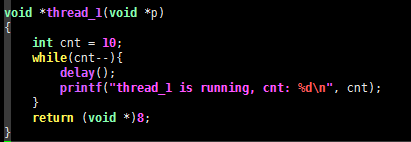C语言陷阱与技巧第46节,如何获取线程函数的执行结果?怎么知道线程函数是成功了还是失败了?
发表于: 2019-06-25 22:20:22 | 已被阅读: 406 | 分类于: C语言
在本专栏的第41节,我们介绍了C语言程序开发中,有些任务可以放在后台运行,以避免主逻辑阻塞,造成C语言程序进入“未响应”等假死状态,影响用户使用体验。
获取线程函数的返回值
在C语言程序开发中,需要放在后台运行的任务通常以线程的形式实现,这一点我们在第 41 节已经举例较为详细的介绍过。不过,第 41 节的例子并未关心线程函数的返回值,而是将其设置为 detached ,以避免资源泄漏。
如果需要得到线程函数的返回值,该怎么做呢?线程函数是后台运行的,乍一看似乎连它什么时候结束都很难知道。
在第 41 节的例子中,主逻辑是通过 while(1) 死循环等待线程函数执行结束的,不过这只适合作为示例,实际的C语言程序开发中,通过死循环等待线程结束的做法肯定是不提倡的。
事实上,C语言的 pthread 库为我们提供的 pthread_join() 函数,就是专门等待线程函数结束,并且获取其返回值的。请看下面这段C语言代码示例:
#include <stdio.h>
#include <pthread.h>
#include <unistd.h>
void delay()
{
unsigned long cnt = 999999;
while(cnt--);
}
void *thread_1(void *p)
{
int cnt = 10;
while(cnt--){
delay();
printf("thread_1 is running, cnt: %d\n", cnt);
}
return NULL;
}
int main()
{
pthread_t pid;
pthread_create(&pid, NULL, thread_1, NULL);
printf("\nmain is running...\n\n");
void *ret;
pthread_join(pid, &ret);
printf("thread exit with ret: %p\n", ret);
return 0;
}

为了尽量简洁,便于讨论主题,示例C语言代码没有做错误处理。
上面这段C语言代码很简单,线程函数 thread_1() 打印 10 次 "thread_1 is running...”, main() 函数创建线程后,调用 pthread_join() 函数等待线程函数结束,并接收其返回值。编译并执行上述C语言代码,得到如下输出:
# gcc t.c -lpthread
# ./a.out
main is running...
thread_1 is running, cnt: 9
thread_1 is running, cnt: 8
thread_1 is running, cnt: 7
thread_1 is running, cnt: 6
thread_1 is running, cnt: 5
thread_1 is running, cnt: 4
thread_1 is running, cnt: 3
thread_1 is running, cnt: 2
thread_1 is running, cnt: 1
thread_1 is running, cnt: 0
thread exit with ret: (nil)
可见,pthread_join() 函数的确可以使 main() 等到线程函数 thread_1() 完成退出,根据上面的输出内容,我们也可以知道 thread_1() 函数返回了 NULL。读者感兴趣的话,可以修改 thread_1() 的返回值,例如:
void *thread_1(void *p)
{
...
return 8;
}

...
thread exit with ret: 0x8
与预期一致。
调用pthread_join()后,线程函数还会“泄漏”资源吗?
之前的文章里说到,在C语言程序开发中创建线程函数,如果不做恰当处理,该线程函数使用的栈等资源无法被系统回收,会造成“资源泄漏”。久而久之,就可能导致整个C语言程序崩溃。
线程函数运行完毕后,系统不回收它的资源,是因为系统不能确定是否仍然有程序关心该线程函数的执行结果。在第 41 节中,我们调用 pthread_detach() 函数告诉系统:没有人关心该线程函数的返回值。所以线程执行完毕后,系统就立刻回收它使用的资源了。
需要说明的是,因为 main() 函数调用 pthread_join() 接收了线程函数 thread_1() 的返回值,也即“有人关心”thread_1() 的执行结果,所以不允许再为 thread_1() 函数设置 detached 标志,这一点要注意。
相对的,如果某个线程函数被设置为 detached,就不能再调用 pthread_join() 等待接收其返回值了。也就是说,在C语言程序开发中,pthread_detach() 和 pthread_join() 二者只能取其一。
可能读者有疑问了,如果C语言程序调用了 pthread_join(),那线程函数不是 detached,会造成“资源泄漏”吗?得到答案最直接的办法就是写代码测试,我们修改 main() 函数的C语言代码:
int main()
{
int i;
pthread_t pid[10];
for(i=0; i<10; i++)
pthread_create(pid+i, NULL, thread_1, NULL);
printf("\nmain is running...\n\n");
void *ret;
for(i=0; i<10; i++)
pthread_join(pid[i], &ret);
printf("thread exit with ret: %p\n", ret);
return 0;
}

这是肯定的,之前系统不回收执行完毕的线程资源,是因为系统不能确定是否仍然有程序关心线程的执行结果,现在 main() 函数调用 pthread_join() 获取了线程的执行结果,系统知道 main() 函数处理了线程的执行结果,于是就可以放心的把资源回收了。
值得说明的是,上述 main() 函数的C语言代码,有些可能会写成下面这样,请看:
int main()
{
int i;
pthread_t pid;
void *ret;
for(i=0; i<10; i++){
pthread_create(&pid, NULL, thread_1, NULL);
pthread_join(pid, &ret);
}
...
return 0;
}
这其实是一个陷阱,初学者很容易跳进去。这段C语言代码有什么问题呢?其实很明显,pthread_join() 函数会
小结
本节主要讨论了C语言程序开发中,获取线程返回值的方法。其实就是 pthread_join() 函数的应用,读者应小心文章最后讨论的“陷阱”。pthread_join() 函数也可以通知系统在线程运行完毕后回收其资源,避免泄漏。但是应该注意,在C语言程序开发中,pthread_detach() 和 pthread_join() 二者只能取其一,实际上,在创建线程后,必须从二者中选择一个:如果主逻辑不关心线程何时结束,也不关心其执行结果,则应该将其设置为 detached。否则,就该调用 pthread_join() 了。